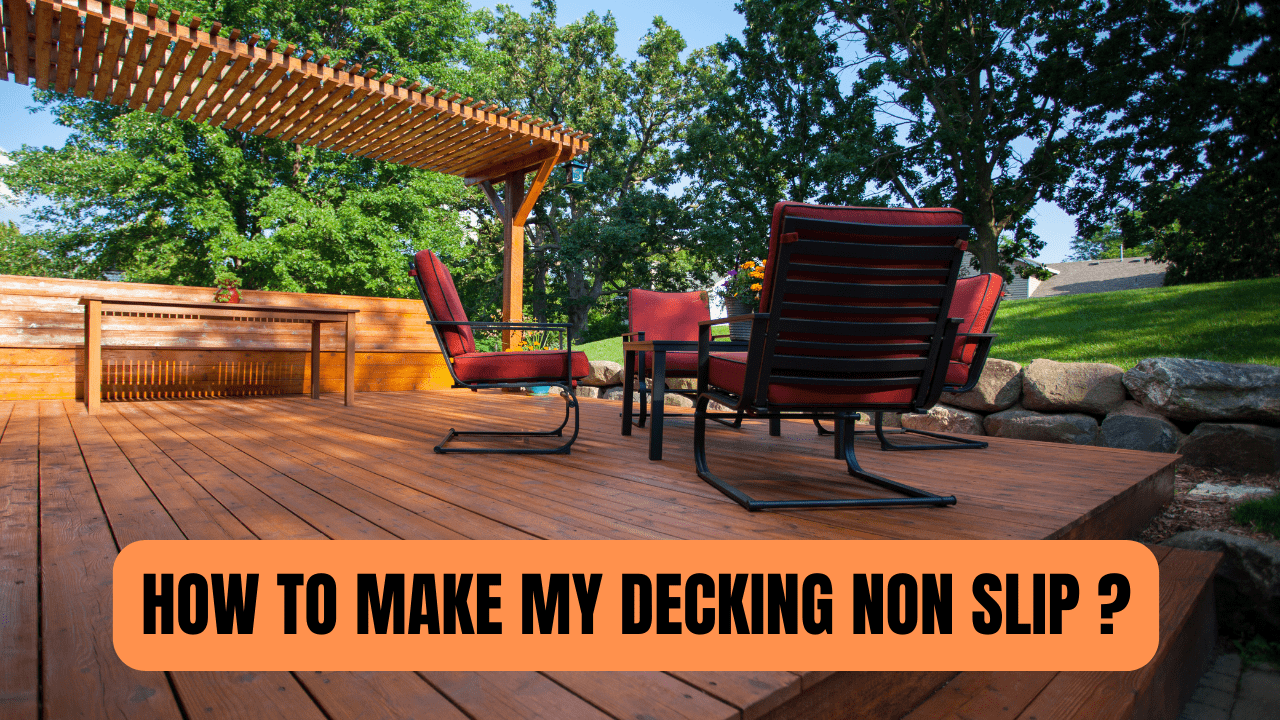Wooden decking is a popular addition to many homes and gardens. Rain and the growth of algae or moss on the wood, on the other hand, can make your decking exceedingly slippery and unsafe.
The problem is exacerbated by autumn leaves, rain, dampness, and chilly temperatures. You’ve come to the right place if you’re looking for solutions for slick decks.
You’ll be relieved to learn that whether you have wood or composite flooring in your yard, there are several easy techniques to make sure it doesn’t send you and your visitors flying. The majority of the wood is not waterproof.
As moisture collects between the fibers of the material, many wood species can become impregnated with water very quickly. Naturally, this isn’t ideal in any situation and can result in various catastrophes.
We are here with the best tips and solutions to avoid slippery decks. Continue reading for further considerations and guidelines:
Table of Contents
Use Non-slip Decking Strips
Decking strips and tape with non-slip properties are specially designed goods. They’re similar to the rubber mats that many people use to protect their decking during the winter.
These strips will stay on your deck for the rest of its life. They’re usually screwed into your deck’s wood and can’t be simply removed. However, they make a much safer decking area that will never be slippery.
Anti-slip tape is a non-permanent adhesive tape that can be applied to any portions of decking that are prone to slippage. Over time, the tape will deteriorate and will need to be discarded. However, it is significantly less expensive and less permanent compared to screwed-in strips.
Add A Coating Of Non-Slip Paint
If your decking still seems a little slick after you’ve cleaned it, a non-slip coating can be the answer. You may buy stains developed specifically for this purpose that will improve the aesthetic of your deck while also increasing the amount of grip.
They usually operate by incorporating microbeads and are more long-lasting than non-slip paint. Furthermore, biocide agents are found in most anti-slip decking dyes. They keep potential slippery biological stuff from growing.
Rough sawn and absorbent wood, on the other hand, will reduce coverage, requiring you to use more. Choose a dry day and remember to work with the wood grain when applying it.
Use Anti-Slip Decking Oil
Anti-Slip Decking Oil is ideal for decking in your home yard, as well as making decked steps safer. However, it’s also an excellent choice for commercial decking in establishments such as commercial areas and restaurants.
Someone will rarely sue you if they slip on your backyard deck. However, anti-slip decking could be disastrous if you run a business, so it’s best to be safe than sorry.
Install Rubber Mats
Rubber mats are a quick and easy solution that many deck owners use to preserve their decking throughout the cold season. Mats are a simple notion – in comparison to other anti-slip decking solutions.
The best thing is that you can install the mats easily whenever needed. Simply lay the weatherproof mats down, let them bear the worst of the winter weather for your decking, and then remove them when spring arrives.
Regular Cleaning And Maintenance
It may seem self-evident, but keeping your slippery deck clean is one of the greatest remedies. Keep in mind that a build-up of moss, algae, and filth can make it dangerous to walk on, so keep up with the upkeep. This includes sweeping away trash and filling in gaps regularly.
As a result, rainwater drains away instead of pooling, reducing the spread of algae. The most basic step is to regularly remove leaves and other damp material, as these are the most common causes of sliding incidents. These components usually begin to accumulate in the autumn. If they’re allowed to build up during the winter, you’ll start to notice more serious issues.
Remove Water And Moisture
When the weather turns significantly colder, any water or moisture that settles on your decking can lead to another slip hazard: ice. The removal of ice from decks is self-explanatory. Your decking might be damaged even with the most careful use of a metal tool.
Meanwhile, sand contains compounds that can harm your decking’s metal and wooden components unless it’s built of composite material. Use a plastic tool or a very small quantity of grit to safely remove any ice, then rinse it away carefully after it has done its work.
Upgrade Your Rotten Deck
It’s probably time to replace your deck if it’s ropey, decaying, and beyond repair. This allows you to take preventative precautions against a slick deck right from the start, as you can choose a textured rather than a smooth one.
This tip, however, comes with a major ‘but.’ Although textured decking provides a more immediate grip, it is more susceptible to algae growth than smooth decking. It’s critical to keep up with the cleaning to preserve its anti-slip function.
Consider Building A Purpose-Designed Deck
If you want to fully replace decking that’s deteriorated due to water, moisture, algae, or other frequent problems that a specially-designed deck can protect you from, purpose-designed non-slip decking is also an excellent alternative.
Anti-slip planks are used to make this type of deck. Several of the functionality listed above are already built-in to these boards. They are typically treated with anti-fungal and anti-insect protection and have non-slip strips built-in.
Conclusion
Not everyone has the time or desire to risk their family’s safety by attempting to make their deck non-slip on their own on a free day.
All decking will deteriorate over time if left untreated as natural oils and resins are lost. After it has dried, decking oil absorbs into the wood and strengthens the cellular structure of your decking. It also helps to replace the natural oils in the wood, extending its life and sturdiness.
Whether you’re doing the installation yourself or hiring a reputable garden landscaper to install or improve your decking, how you’ll keep it from becoming slippery is something you should consider or discuss.





